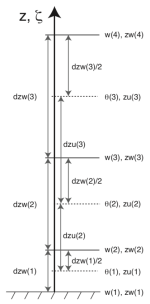Good day,
Thanks for being a help to us newbies.
I am writing to find how to post-process wind components and geopotential Height across all levels from the MPAS model.
I have ran a 10 day variable resolution simulation with MPAS and I am about to analyze, since I don't know much about how the model runs or the variables the model produces, I have gotten some stream_list.atmosphere.(diagnostics, output) ( all attached including the namelist and the streams.atmosphere) to run the model. In those files, I found numerous variable name there, but couldn't found (or notice) any one of them to give the idea of u(zonal wind component) or v(meridional wind component), geopotential height and vertical windspeed at levels.
I have configured the simulations to output diagnostics file at every day as below:
//////////////////////////////////
diag.2009-01-01_00.00.00.nc
diag.2009-01-02_00.00.00.nc
diag.2009-01-03_00.00.00.nc
diag.2009-01-04_00.00.00.nc
///////////////////////////////////
I want to post-process u, v, geopotential height and the vertical from the diag file using convert_mpas tool to get a single file (latlon.nc), but I don't know which of the variable names in the output and the diagnostic stream_list I should include in the convert_mpas include_field.
Please can anyone put me through this?
I have gone through the user guide, but couldn't find useful information about these particular variables, may they need to be calculated?
If so, at least I will need some other parameters (variables) like wind speed to calculate some of the above listed variables.
please any help will be appreciated.
Thanks so much for your usual help.
Thanks for being a help to us newbies.
I am writing to find how to post-process wind components and geopotential Height across all levels from the MPAS model.
I have ran a 10 day variable resolution simulation with MPAS and I am about to analyze, since I don't know much about how the model runs or the variables the model produces, I have gotten some stream_list.atmosphere.(diagnostics, output) ( all attached including the namelist and the streams.atmosphere) to run the model. In those files, I found numerous variable name there, but couldn't found (or notice) any one of them to give the idea of u(zonal wind component) or v(meridional wind component), geopotential height and vertical windspeed at levels.
I have configured the simulations to output diagnostics file at every day as below:
//////////////////////////////////
diag.2009-01-01_00.00.00.nc
diag.2009-01-02_00.00.00.nc
diag.2009-01-03_00.00.00.nc
diag.2009-01-04_00.00.00.nc
///////////////////////////////////
I want to post-process u, v, geopotential height and the vertical from the diag file using convert_mpas tool to get a single file (latlon.nc), but I don't know which of the variable names in the output and the diagnostic stream_list I should include in the convert_mpas include_field.
Please can anyone put me through this?
I have gone through the user guide, but couldn't find useful information about these particular variables, may they need to be calculated?
If so, at least I will need some other parameters (variables) like wind speed to calculate some of the above listed variables.
please any help will be appreciated.
Thanks so much for your usual help.

